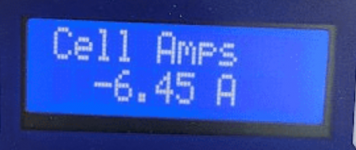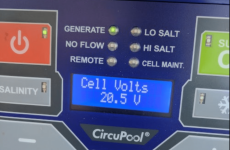- Jun 22, 2014
- 52,018
- Pool Size
- 17888
- Surface
- Fiberglass
- Chlorine
- Salt Water Generator
- SWG Type
- CircuPool RJ-45 Plus
That's a big difference and it might indicate a difference in performance on different polarities.Salt levels are fun:
Module Salinity - 4,400
Module Avg Salt - 3,200
Taylor K-1766 - 3,800


My unit is about as accurate as yours, my Taylor kit says 2800 but the unit says 3300. Should I add more salt?Salt levels are fun:
Module Salinity - 4,400
Module Avg Salt - 3,200
Taylor K-1766 - 3,800
Nothing like consistency huh? Ha ha
But you gave me some good details about the votes/amps to monitor.I'll watch those closely for the next few days to see if they fluctuate well out of range. This could certainly influence a potential warranty claim from the cell to the module itself. My first two seasons I ran at 30% output 24/7 which according to PoolMath is 4 ppm per day. This was the first time (3rd season) 30% was struggling which prompted me to crunch numbers like this. I expect a cell to wear over time and slowly lose some of its production, but this seemed kind of sudden. I'll continue to monitor.
I usually leave it alone if the SWG is happy and not throwing any red lights or errors. But if you are really concerned, you could add about 200 ppm which keeps both items in that 3,000 - 3,500 ballpark.My unit is about as accurate as yours, my Taylor kit says 2800 but the unit says 3300. Should I add more salt?
Did you have happen to check and remember what those numbers were early on?Salt levels are fun:
Module Salinity - 4,400
Module Avg Salt - 3,200
Taylor K-1766 - 3,800
Nothing like consistency huh? Ha ha
But you gave me some good details about the votes/amps to monitor.I'll watch those closely for the next few days to see if they fluctuate well out of range. This could certainly influence a potential warranty claim from the cell to the module itself. My first two seasons I ran at 30% output 24/7 which according to PoolMath is 4 ppm per day. This was the first time (3rd season) 30% was struggling which prompted me to crunch numbers like this. I expect a cell to wear over time and slowly lose some of its production, but this seemed kind of sudden. I'll continue to monitor.
Here are my results. I did the production test first night and followed up with OCLT test the following night (0.0 OCLT loss). I used 25 mL samples, repeated each test 3X and noted the average result.UNIT: RJ-45+
AGE: 27 months
HOURS (Nighttime) TESTED: 7
OUTPUT SETTING: 100%
PROJECTED FC OUTPUT (per Poolmath) - 3.9 ppm
ACTUAL FC OUTPUT: 2.5
The salt could certainly be a factor. These are nighttime FC production tests though, so the CYA shouldn't be a player unless someone is sharing daytime results.I think it would be important while comparing to also note the CYA and salinity as those contribute to the cells efficiency.
True, but the CYA is a factor what remains through the day for the night test.The salt could certainly be a factor. These are nighttime FC production tests though, so the CYA shouldn't be a player unless someone is sharing daytime results.
Pat is running out to get more test strips now to retestGuys, I think it would be important while comparing to also note the CYA and salinity as those contribute to the cells efficiency.
My edge doesn’t show the power but I will see how many watts my smart plug pulls when I Rear salt next time. Last check I was around 3200 so need to add a couple more soonThe salt could certainly be a factor. These are nighttime FC production tests though, so the CYA shouldn't be a player unless someone is sharing daytime results.
Funny thing, those who know me know I'm OCD about tracking data - spreadsheets specifically. I have one for just about everything at home to track things (bills, maintenance, etc). I started another spreadsheet a few days ago for all the data on my RJ module, so I'll include that at some point. But of course the module Salinity Now and average levels never match-up with my K-1766. HaPat is running out to get more test strips now to retest
Added to my post.Guys, I think it would be important while comparing to also note the CYA and salinity as those contribute to the cells efficiency.
That’s why I was joking CP “ sir what is your free chlorine and have you tracked it” Pat “ what date and time do you want? Want my CSI also”Funny thing, those who know me know I'm OCD about tracking data - spreadsheets specifically. I have one for just about everything at home to track things (bills, maintenance, etc). I started another spreadsheet a few days ago for all the data on my RJ module, so I'll include that at some point. But of course the module Salinity Now and average levels never match-up with my K-1766. Ha

